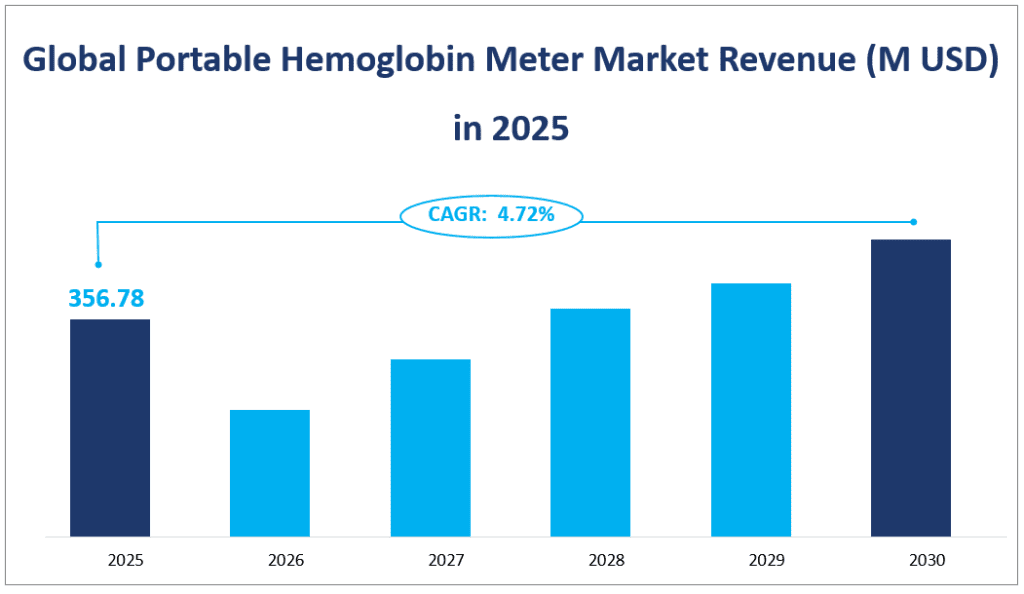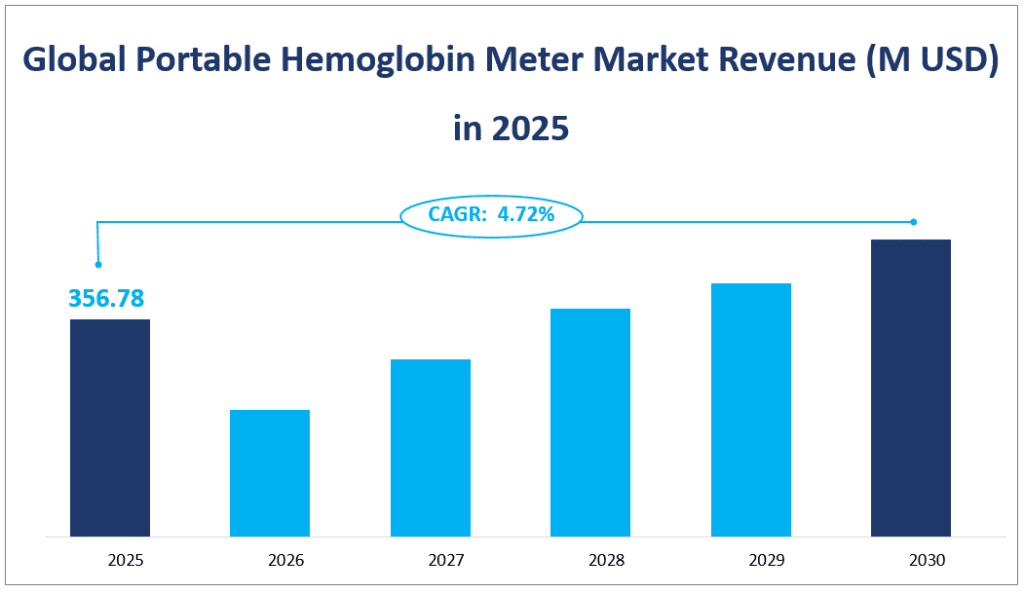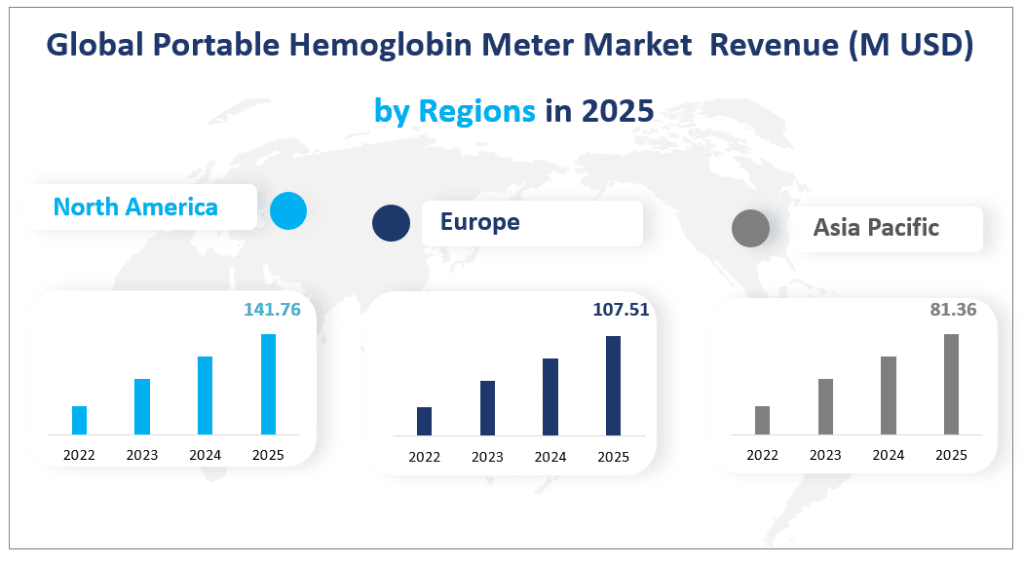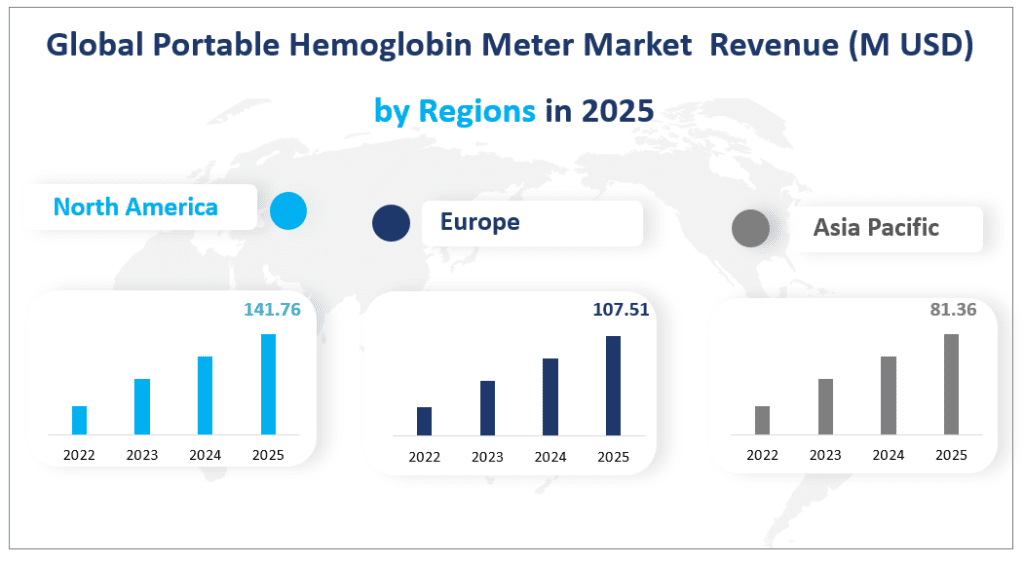1. Global Portable Hemoglobin Market Summary
In 2025, the global portable hemoglobin meter market is projected to reach a sales volume of 1,295.2 thousand units with a CAGR of 5.41% from 2025 to 2030.
A portable hemoglobin meter is an essential medical device designed to quickly measure the hemoglobin levels in blood. It operates primarily through spectrophotometry, providing rapid results that are crucial for diagnosing conditions such as anemia, internal bleeding, and other hemoglobin-related disorders. These devices are widely used in hospitals, laboratories, and home care settings, offering healthcare professionals and patients a convenient and efficient way to monitor hemoglobin levels without the need for traditional laboratory testing.
Global Portable Hemoglobin Meter Market Revenue (M USD) in 2025


2. Driving Factors of Portable Hemoglobin Market
Increasing Prevalence of Chronic Diseases: The rise in chronic conditions such as diabetes, cardiovascular diseases, and kidney disorders has led to a higher demand for regular hemoglobin monitoring. Portable hemoglobin meters offer a convenient solution for patients to manage their health conditions effectively.
Need for Point-of-Care Diagnostics: In an era where time is of the essence, the demand for rapid diagnostic tools has surged. Portable hemoglobin meters provide quick results, reducing the time and cost associated with traditional laboratory tests. This is particularly beneficial in emergencies and for routine check-ups in outpatient settings.
Aging Population: The global increase in the elderly population has heightened the need for health monitoring tools. Older adults are more susceptible to anemia and other chronic diseases, making portable hemoglobin meters an essential part of their healthcare routine. The convenience of these devices allows for regular monitoring without frequent hospital visits.
Technological Advancements: Innovations in technology have led to the development of more accurate, reliable, and user-friendly portable hemoglobin meters. Features such as Bluetooth connectivity, data storage, and easy-to-read displays enhance the user experience and contribute to the market’s growth.
Integration with Mobile Devices: The ability to connect portable hemoglobin meters to smartphones and other mobile devices has revolutionized health monitoring. Users can now track their hemoglobin levels over time, share data with healthcare providers, and receive personalized health insights, further driving the adoption of these devices.
3. Limiting Factors of Portable Hemoglobin Market Growth
Strict Regulatory Environment: The portable hemoglobin meter market is subject to stringent regulations and approval processes in various regions. Companies must comply with standards such as FDA and CE certifications, which can be time-consuming and costly. This regulatory burden can delay product launches and market entry, particularly for new entrants.
Accuracy and Consistency Challenges: Achieving high accuracy and consistency in hemoglobin measurements is crucial for reliable diagnoses. Variations in test results due to environmental factors or user error can lead to misdiagnoses and undermine user trust. Regular calibration and maintenance are required to ensure accurate readings, adding to the operational complexity.
Operational Complexity: Some semi-automatic portable hemoglobin meters require specific operating knowledge, which can be a barrier for users, especially the elderly. The complexity of data reading and interactive interfaces can affect user experience and limit the market’s reach.
Economic Constraints: Inflation and rising raw material costs can impact the production and pricing of portable hemoglobin meters. Increased production costs may lead to higher prices for consumers, potentially reducing demand, especially in price-sensitive markets.
4. Portable Hemoglobin Meter Market Segment
Product Types
The global portable hemoglobin meter market is segmented into two primary product types: full-automatic and semi-automatic devices. Each type serves distinct needs within the healthcare sector, influencing their market adoption and growth dynamics.
In 2025, the market is projected to witness a sales volume of 907.6 thousand units for full-automatic devices and 387.7 thousand units for semi-automatic devices. This indicates that full-automatic portable hemoglobin meters hold a significantly larger market share compared to their semi-automatic counterparts.
Full-automatic portable hemoglobin meters are designed to provide rapid, consistent, and minimally invasive testing. These devices are particularly favored in high-volume clinical settings such as emergency rooms and hospitals, where quick and accurate results are crucial. The market’s preference for full-automatic devices is evident in their substantial market share, which is expected to grow further as healthcare providers increasingly seek efficient diagnostic solutions.
Semi-automatic devices, while less popular than full-automatic ones, still play a vital role in specific healthcare scenarios. These devices require some manual intervention during the measurement process, which may introduce variability in results. However, they offer a cost-effective alternative for settings where full automation is not necessary. The market for semi-automatic devices is expected to grow at a steady pace, driven by demand from smaller clinics and laboratories.
Analysis of Different Applications
Hospitals represent the largest market share for portable hemoglobin meters, with a projected sales volume of 728.8 thousand units in 2025. This dominance is attributed to the critical need for rapid and accurate hemoglobin testing in emergency and routine care settings. Portable hemoglobin meters enable healthcare providers to make quick diagnostic decisions, improving patient outcomes and operational efficiency. The increasing prevalence of chronic diseases and the growing elderly population further drive the demand for these devices in hospitals.
Laboratories account for a significant portion of the market, with a projected sales volume of 143.9 thousand units in 2025. These devices are essential for routine blood testing and screening of various blood disorders, including anemia and hemoglobinopathies. The consistent demand for laboratory testing ensures a stable market for portable hemoglobin meters in this application.
The household segment is experiencing notable growth, with a projected sales volume of 322.8 thousand units in 2025. This growth is driven by the increasing awareness of health management among individuals, especially those with chronic conditions such as diabetes and cardiovascular diseases. Portable hemoglobin meters offer a convenient solution for regular monitoring at home, reducing the need for frequent hospital visits and empowering patients to take control of their health.
While hospitals continue to dominate the market in terms of sales volume, the household segment is expected to exhibit the fastest growth rate. This trend is driven by the increasing prevalence of chronic diseases, the growing elderly population, and the rising demand for convenient health monitoring solutions. The ability to monitor hemoglobin levels at home provides significant benefits, including early detection of health issues and reduced healthcare costs.
Market Sales by Segment
| Sales Volume (K Units) in 2025 | ||
| By Type | Full-automatic | 907.6 |
| Semi-automatic | 387.7 | |
| By Application | Hospital | 728.8 |
| Lab | 143.9 | |
| Household | 322.8 | |
| Other | 99.7 |
5. Regional Portable Hemoglobin Meter Market Analysis
North America is anticipated to remain the largest regional market for portable hemoglobin meters in 2025, with an estimated revenue of $141.76 million. The region’s dominance is attributed to several factors, including a high level of economic development, significant healthcare expenditure, and a robust healthcare infrastructure. The United States, in particular, drives the market due to its strong demand for advanced medical technologies and a high adoption rate of portable diagnostic devices. Additionally, the presence of major healthcare companies and research institutions in North America further supports the growth of the portable hemoglobin meter market.
Europe is another significant contributor to the global portable hemoglobin meter market, with an estimated revenue of $107.51 million in 2025. The region’s market is characterized by strong healthcare systems, high per capita income, and a growing elderly population. The market in Europe is also supported by the integration of digital health solutions, which promotes the adoption of connected medical devices.
While North America and Europe dominate the market in terms of revenue, the Asia Pacific region is emerging as the fastest-growing market. In 2025, the Asia Pacific market is projected to generate a revenue of $81.36 million, with a significant growth rate driven by several factors. The region’s rapid economic growth, particularly in countries like China and India, is leading to increased healthcare spending and a higher demand for medical technologies.
Latin America and the Middle East & Africa are also contributing to the global market, with projected revenues of $16.92 million and $9.24 million respectively in 2025. These regions are characterized by growing healthcare awareness and increasing adoption of advanced medical technologies. While their market sizes are smaller compared to North America, Europe, and Asia Pacific, they are poised for steady growth driven by improving healthcare infrastructure and rising demand for convenient diagnostic solutions.
Global Portable Hemoglobin Meter Market Revenue (M USD) by Regions in 2025


6. Top 3 Companies in the Portable Hemoglobin Meter Market
Company Introduction and Business Overview
HemoCue is a leading provider of portable hemoglobin meters, known for its innovative and reliable diagnostic solutions. Established in 1982 and headquartered in Sweden, HemoCue is a subsidiary of Danaher Corporation, a global science and technology leader. The company’s products are used in over 130 countries, making it a significant player in the global healthcare market. HemoCue’s business focuses on delivering high-quality diagnostic tools that are easy to use and provide rapid results, particularly in point-of-care settings.
Products Offered
HemoCue offers a variety of portable hemoglobin meters, including the HemoCue Hb 801 System. This device is designed for use in hospitals and other healthcare settings, providing results in less than one second. The system’s innovative design and proven microcuvette technology make it a preferred choice for healthcare professionals who require quick and accurate hemoglobin measurements.
In 2024, HemoCue’s portable hemoglobin meter sales revenue reached $48.10 million, reflecting its strong market position and continued growth.
Company Introduction and Business Overview
Abbott Laboratories is a multinational healthcare company headquartered in the United States. Established in 1888, Abbott is a global leader in medical devices, diagnostic products, and nutritional solutions. The company’s extensive portfolio includes innovative point-of-care diagnostic systems that are widely used in hospitals, clinics, and home care settings. Abbott’s commitment to advancing healthcare through innovative solutions has solidified its position as a key player in the portable hemoglobin meter market.
Products Offered
Abbott’s i-STAT 1 portable blood analysis system is a notable product in the market. This lightweight and easy-to-use device provides lab-quality diagnostic results in minutes, making it ideal for point-of-care testing. The i-STAT system is designed to accelerate clinical decision-making by delivering rapid and accurate results directly to healthcare providers.
In 2024, Abbott’s portable hemoglobin meter sales revenue was $39.01 million, highlighting its significant contribution to the market.
Company Introduction and Business Overview
Siemens Healthineers, a subsidiary of Siemens AG, is a global leader in medical imaging and laboratory diagnostics. Established in 1847 and headquartered in Germany, Siemens Healthineers focuses on expanding precision medicine through personalized diagnosis and treatment. The company’s innovative solutions are designed to improve patient outcomes and streamline healthcare delivery.
Products Offered
Siemens’ epoc® Blood Analysis System is a handheld, wireless solution that provides comprehensive blood analysis testing at the patient’s side. The system delivers lab-quality results in less than a minute, making it a valuable tool for healthcare providers in various settings. The epoc system’s single room-temperature test card and wireless capabilities enhance its usability and efficiency.
In 2024, Siemens’ portable hemoglobin meter sales revenue reached $34.70 million, reflecting its strong market presence and continued growth.
Major Players
| Company Name | Headquarter Location | Sales Region |
| HemoCue | Sweden | Worldwide |
| Abbott | USA | Worldwide |
| Siemens | Germany | Worldwide |
| EKF Diagnostics | U.K. | Mainly in Europe and North America |
| PTS Diagnostics | USA | Mainly in North America, Latin America, Europe, and Asia Pacific |
| GREEN CROSS MEDIS | Korea | Mainly in Asia |
| ACON | USA | Mainly in North America, Europe, Asia Pacific, Middle East, and Africa |
| Fresenius Kabi AG | India | Mainly in Asia Pacific |
| Wrig Nanosystems Private Limited | India | Mainly in India |
| Sensa Core Medical | India | Mainly in India |
| Konsung Medical Group | China | Mainly in Asia |
1. Market Definition and Statistical Scope
1.1 Objective of the Study
1.2 Portable Hemoglobin Meter Market Definition
1.3 Market Scope
1.3.1 Market Segmentation by Type, Application
1.3.2 Major Geographies Covered (North America, Europe, Asia Pacific, Middle East & Africa, Latin America)
1.4 Years Considered for the Study (2019-2030)
1.5 Currency Considered
2 Key Companies’ Profile
2.1 Competitive Profile
2.1.1 Global Portable Hemoglobin Meter Sales Volume Market Share by Companies
2.1.2 Global Portable Hemoglobin Meter Revenue Market Share by Companies
2.2 HemoCue
2.2.1 Brief Introduction of HemoCue
2.2.2 Product Introduction
2.2.3 HemoCue Sales, Growth Rate and Global Market Share from 2019-2024
2.3 Abbott
2.3.1 Brief Introduction of Abbott
2.3.2 Product Introduction
2.3.3 Abbott Sales, Growth Rate and Global Market Share from 2019-2024
2.4 Siemens
2.4.1 Brief Introduction of Siemens
2.4.2 Product Introduction
2.4.3 Siemens Sales, Growth Rate and Global Market Share from 2019-2024
2.5 EKF Diagnostics
2.5.1 Brief Introduction of EKF Diagnostics
2.5.2 Product Introduction
2.5.3 EKF Diagnostics Sales, Growth Rate and Global Market Share from 2019-2024
2.6 PTS Diagnostics
2.6.1 Brief Introduction of PTS Diagnostics
2.6.2 Product Introduction
2.6.3 PTS Diagnostics Sales, Growth Rate and Global Market Share from 2019-2024
2.7 GREEN CROSS MEDIS
2.7.1 Brief Introduction of GREEN CROSS MEDIS
2.7.2 Product Introduction
2.7.3 GREEN CROSS MEDIS Sales, Growth Rate and Global Market Share from 2019-2024
2.8 ACON
2.8.1 Brief Introduction of ACON
2.8.2 Product Introduction
2.8.3 ACON Sales, Growth Rate and Global Market Share from 2019-2024
2.9 Fresenius Kabi AG
2.9.1 Brief Introduction of Fresenius Kabi AG
2.9.2 Product Introduction
2.9.3 Fresenius Kabi AG Sales, Growth Rate and Global Market Share from 2019-2024
2.10 Wrig Nanosystems Private Limited
2.10.1 Brief Introduction of Wrig Nanosystems Private Limited
2.10.2 Product Introduction
2.10.3 Wrig Nanosystems Private Limited Sales, Growth Rate and Global Market Share from 2019-2024
2.11 Sensa Core Medical
2.11.1 Brief Introduction of Sensa Core Medical
2.11.2 Product Introduction
2.11.3 Sensa Core Medical Sales, Growth Rate and Global Market Share from 2019-2024
2.12 Konsung Medical Group
2.12.1 Brief Introduction of Konsung Medical Group
2.12.2 Product Introduction
2.12.3 Konsung Medical Group Sales, Growth Rate and Global Market Share from 2019-2024
3. Global Portable Hemoglobin Meter Market Segmented by Type
3.1 Global Portable Hemoglobin Meter Sales Volume, Revenue and Growth Rate by Type 2019-2024
3.2 Full-automatic
3.3 Semi-automatic
4 Global Portable Hemoglobin Meter Market Segmented by Downstream Industry
4.1 Global Portable Hemoglobin Meter Sales Volume, Revenue and Growth Rate by Downstream Industry 2019-2024
4.2 Hospital
4.3 Lab
4.4 Household
5 Portable Hemoglobin Meter Industry Chain Analysis
5.1 Value Chain Status
5.2 Upstream Raw Material Suppliers of Portable Hemoglobin Meter Analysis
5.3 Major Players of Portable Hemoglobin Meter
5.3.1 Major Players Headquarter of Portable Hemoglobin Meter in 2023
5.3.2 Major Players Sales Region in 2023
5.4 Manufacturing Costs Structure of Portable Hemoglobin Meter
5.4.1 Raw Materials Cost
5.4.2 Labor Cost
5.5 Market Channel Analysis of Industry
5.6 Major Downstream Buyers of Portable Hemoglobin Meter Analysis
6. The Development and Dynamics of Portable Hemoglobin Meter Market
6.1 Driving Market of Portable Hemoglobin Meter
6.2 Challenging Market of Portable Hemoglobin Meter
6.3 Opportunities of the Portable Hemoglobin Meter Market
6.4 Industry News
6.5 The Impact of Regional Situation on Portable Hemoglobin Meter Industries
6.6 The Impact of Inflation on Portable Hemoglobin Meter Industries
6.7 The Transformative Power of AI on Portable Hemoglobin Meter Industries
6.8 New Entrants SWOT Analysis
7 Global Portable Hemoglobin Meter Market Segmented by Geography
7.1 Global Portable Hemoglobin Meter Revenue and Market Share by Region 2019-2024
7.2 Global Portable Hemoglobin Meter Sales Volume and Market Share by Region 2019-2024
8 North America
8.1 North America Portable Hemoglobin Meter Sales Volume, Price, Revenue, Gross Margin and Gross Analysis from 2019-2024
8.2 North America Portable Hemoglobin Meter Sales Volume Analysis from 2019-2024
8.3 North America Portable Hemoglobin Meter Import and Export from 2019-2024
8.4 North America Portable Hemoglobin Meter Market by Country
8.4.1 North America Portable Hemoglobin Meter Sales Volume by Country (2019-2024)
8.4.2 North America Portable Hemoglobin Meter Revenue by Country (2019-2024)
8.4.3 United States Portable Hemoglobin Meter Sales Volume and Growth (2019-2024)
8.4.4 Canada Portable Hemoglobin Meter Sales Volume and Growth (2019-2024)
9 Europe
9.1 Europe Portable Hemoglobin Meter Sales Volume, Price, Revenue, Gross Margin and Gross Analysis from 2019-2024
9.2 Europe Portable Hemoglobin Meter Sales Volume Analysis from 2019-2024
9.3 Europe Portable Hemoglobin Meter Import and Export from 2019-2024
9.4 Europe Portable Hemoglobin Meter Market by Country
9.4.1 Europe Portable Hemoglobin Meter Sales Volume by Country (2019-2024)
9.4.2 Europe Portable Hemoglobin Meter Revenue by Country (2019-2024)
9.4.3 Germany Portable Hemoglobin Meter Sales Volume and Growth (2019-2024)
9.4.4 UK Portable Hemoglobin Meter Sales Volume and Growth (2019-2024)
9.4.5 France Portable Hemoglobin Meter Sales Volume and Growth (2019-2024)
9.4.6 Italy Portable Hemoglobin Meter Sales Volume and Growth (2019-2024)
9.4.7 Spain Portable Hemoglobin Meter Sales Volume and Growth (2019-2024)
9.4.8 Russia Portable Hemoglobin Meter Sales Volume and Growth (2019-2024)
9.4.9 Netherlands Portable Hemoglobin Meter Sales Volume and Growth (2019-2024)
9.4.10 Turkey Portable Hemoglobin Meter Sales Volume and Growth (2019-2024)
9.4.11 Switzerland Portable Hemoglobin Meter Sales Volume and Growth (2019-2024)
9.4.12 Sweden Portable Hemoglobin Meter Sales Volume and Growth (2019-2024)
10 Asia Pacific
10.1 Asia Pacific Portable Hemoglobin Meter Sales Volume, Price, Revenue, Gross Margin and Gross Analysis from 2019-2024
10.2 Asia Pacific Portable Hemoglobin Meter Sales Volume Analysis from 2019-2024
10.3 Asia Pacific Portable Hemoglobin Meter Import and Export from 2019-2024
10.4 Asia Pacific Portable Hemoglobin Meter Market by Country
10.4.1 Asia Pacific Portable Hemoglobin Meter Sales Volume by Country (2019-2024)
10.4.2 Asia Pacific Portable Hemoglobin Meter Revenue by Country (2019-2024)
10.4.3 China Portable Hemoglobin Meter Sales Volume and Growth (2019-2024)
10.4.4 Japan Portable Hemoglobin Meter Sales Volume and Growth (2019-2024)
10.4.5 South Korea Portable Hemoglobin Meter Sales Volume and Growth (2019-2024)
10.4.6 Australia Portable Hemoglobin Meter Sales Volume and Growth (2019-2024)
10.4.7 India Portable Hemoglobin Meter Sales Volume and Growth (2019-2024)
10.4.8 Indonesia Portable Hemoglobin Meter Sales Volume and Growth (2019-2024)
10.4.9 Philippines Portable Hemoglobin Meter Sales Volume and Growth (2019-2024)
10.4.10 Malaysia Portable Hemoglobin Meter Sales Volume and Growth (2019-2024)
11 Latin America
11.1 Latin America Portable Hemoglobin Meter Sales Volume, Price, Revenue, Gross Margin and Gross Analysis from 2019-2024
11.2 Latin America Portable Hemoglobin Meter Sales Volume Analysis from 2019-2024
11.3 Latin America Portable Hemoglobin Meter Import and Export from 2019-2024
11.4 Latin America Portable Hemoglobin Meter Market by Country
11.4.1 Latin America Portable Hemoglobin Meter Sales Volume by Country (2019-2024)
11.4.2 Latin America Portable Hemoglobin Meter Revenue by Country (2019-2024)
11.4.3 Brazil Portable Hemoglobin Meter Sales Volume and Growth (2019-2024)
11.4.4 Mexico Portable Hemoglobin Meter Sales Volume and Growth (2019-2024)
11.4.5 Argentina Portable Hemoglobin Meter Sales Volume and Growth (2019-2024)
12 Middle East & Africa
12.1 Middle East & Africa Portable Hemoglobin Meter Sales Volume, Price, Revenue, Gross Margin and Gross Analysis from 2019-2024
12.2 Middle East & Africa Portable Hemoglobin Meter Sales Volume Analysis from 2019-2024
12.3 Middle East & Africa Portable Hemoglobin Meter Import and Export from 2019-2024
12.4 Middle East & Africa Portable Hemoglobin Meter Market by Country
12.4.1 Middle East & Africa Portable Hemoglobin Meter Sales Volume by Country (2019-2024)
12.4.2 Middle East & Africa Portable Hemoglobin Meter Revenue by Country (2019-2024)
12.4.3 Saudi Arabia Portable Hemoglobin Meter Sales Volume and Growth (2019-2024)
12.4.4 UAE Portable Hemoglobin Meter Sales Volume and Growth (2019-2024)
12.4.5 Egypt Portable Hemoglobin Meter Sales Volume and Growth (2019-2024)
12.4.6 South Africa Portable Hemoglobin Meter Sales Volume and Growth (2019-2024)
13. Global Portable Hemoglobin Meter Market Forecast by Geography, Type, and Downstream Industry 2024-2030
13.1 Forecast of the Global Portable Hemoglobin Meter Market from 2024-2030 by Region
13.2 Global Portable Hemoglobin Meter Sales Volume Forecast by Type (2024-2030)
13.3 Global Portable Hemoglobin Meter Sales Volume Forecast by Downstream Industry (2024-2030)
14 Appendix
14.1 Methodology
14.2 Research Data Source
14.2.1 Secondary Data
14.2.2 Primary Data
14.2.3 Market Size Estimation
14.2.4 Legal Disclaimer
